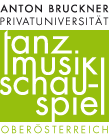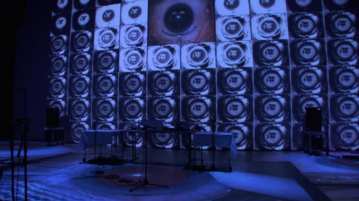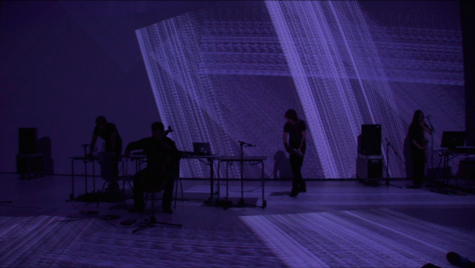Sonic
Intermedia 2010 : UEA
intermediale
Computermusik
-
Konzert
und Vortrag
zu Gast: UEA-Studios,
University
of East Anglia, UK
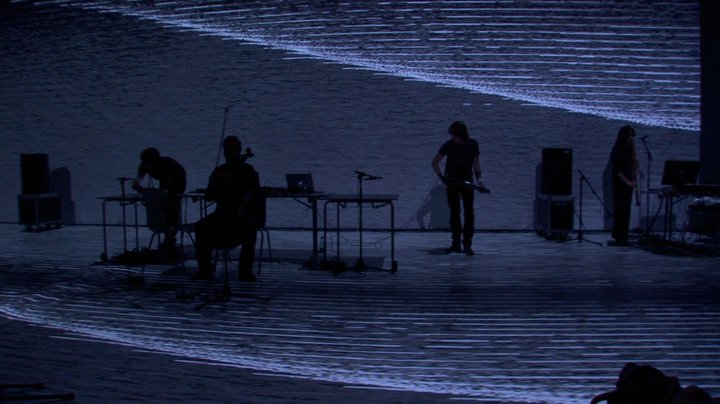
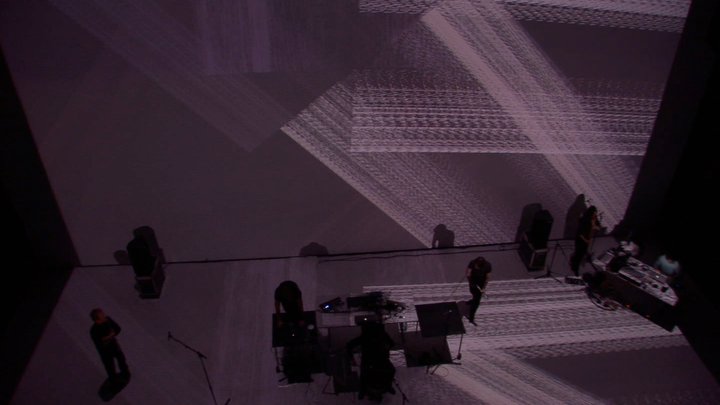
KONZERT
Mo
18. Oktober
2010,
19.30 h
im
DeepSpace des AEC
- Ars Electronica Centre Linz
raumgroße
Projektionen
mit periphonen Schallfeldern
Ein
spannendes
Konzert experimenteller Computermusik,
elektroakustischer und
intermedialer Komposition mit
einem hochkarätigen Team von KomponistInnen,
ForscherInnen und
MusikerInnen der UEA-Studios,
University
of
East
Anglia,
der
Anton-Bruckner-Privatuniversität und assoziierten
KünstlerInnen.
Der Deep Space ist der
ideale Ort
für dieses Konzert: Giga-Pixel-Bilder und
Projektionsmöglichkeiten auf
16 x 9 Meter Wand und Boden ergänzen Computermusik
im Surround
Sound
und machen den Abend zu einem ganz besonderen
räumlichen
Medienereignis.
Werke
von und mit
Simon
Waters, Elektronik
Ed
Perkins,
Elektronik
Bill
Vine, Weingläser,
Elektronik
Anton
Lukoszevieze, Violoncello
Se-Lien
Chuang, Visuals,
Bassblockflöte
Andreas
Weixler, Elektronik
EINTRITT FREI !
VORTRAG
Di
19. Oktober
2010, 15.00 Uhr
Dr.
Simon Waters
Sound structures,
social structures,
technical structures:
Changing
practices
and
behaviours
in a UK university studio 1973-2010.
an
der
Anton-Bruckner-Privatuniversität, kleiner Saal
CMS invited lecture
series
EINTRITT
FREI !
Leitung/Organisation: Andreas Weixler,
Se-Lien Chuang
und Simon Waters
Eine
Kooperation von AEC
und
Anton-Bruckner-Privatuniversität in Linz
mit der Konzertserie Sonic
Arts der
School
of Music of the University
of
East Anglia, Norwich, UK
Sonic
Intermedia -
Konzert- & Vortragsreihe
Mit dem Deep
Space
bietet das ars electronica center einen
außergewöhnlichen Ort an. Giga-Pixel visuelle
Projektion und
Mehrkanal-Computermusik mit neuesten digitalen Konzepten und
Entwicklungen, machen den Abend zu
einem unvergesslichen räumlichen Medienereignis am 18. Oktober
2010.
Am 19. Oktober können Sie mehr erfahren über die
Hintergründe, aktuelle Forschungs- und Kunstrichtungen
aus dem
Bereich Computermusik und über die UEA Studios der
University of East Anglia, die heuer zu Gast bei Sonic Intermedia sind.
Sonic
Intermedia ist eine neue Konzertreihe initiert von
den
KomponistInnen
und MedienkünstlerInnen Andreas
Weixler und Se-Lien
Chuang
mit dem künstlerischen
Leiter des AEC Gerfried Stocker um zeitgenössischer
intermedialer Computermusik ein Präsentationsformat in
Linz zu
geben.
Mit Sonic
Intermedia wird
ein
neues Konzertformat für intermediale
Klangkunst in Kooperation der
Anton-Bruckner-Privatuniversität mit
dem Ars Electronica Center vorgestellt. Es erwartet Sie ein
spannendes
Konzert experimenteller Computermusik und intermedialer
Komposition mit
einem hochkarätigen Team von KomponistInnen,
ForscherInnen,
MedienkünstlerInnen und
MusikerInnen.
Das diesjährige Sonic
Intermedia
ist eine Kooperation von AEC
-
Ars Electronic Center und
ABPU
Anton-Bruckner-Privatuniversität in Linz mit der
Konzertserie Sonic Arts der
School of Music
of
the University of East Anglia - UEA,
Norwich,
UK.
UEA
STUDIOS
The electroacoustic music studios of the University of East Anglia
(in
Norwich, UK) have maintained a position with regard to music’s
engagement with technology out of all proportion to their scale.
From
the early 1970s the studios promoted multi-loudspeaker sound
diffusion
for the performance of electroacoustic music, initiating the
longest
continuously-running concert series of such music (still running
today
as the
Sonic Arts
series).
During the 1980s the then studio director
Denis Smalley introduced the notion of ‘spectromorphology’ which
was to
provide critical and descriptive tools for the genre. In the 1990s
under new director Simon Waters the studios were quick to adopt
new
approaches involving both high-tech (real-time and networked
performance) and low-tech (hardware hacking) solutions to musical
problems. The introduction in 2009 of a new undergraduate
programme in
Music and Technology has brought the combination of experiment and
rigour which characterised the studio’s research programmes to a
much
wider audience of potential students.
Associates and alumni of the UEA studio have a history of
association
with Ars Electronica, most notably Denis Smalley’s Golden Nica in
1988
(for Clarinet Threads) and Jonathan Impett’s prize for
Mirror-Rite, a
work for metatrumpet, in 1994.
The programme for the
Sonic
Intermedia concert includes new work for
cello and electronics by current studio director Simon Waters
(featuring Anton Lukoszevieze, cellist and director of new music
ensemble Apartment House) and works by current Phd students as
well as
alumni.
Programm
 Die Augenblicke in seinen
Händen /
Dichte4Dichtl
Die Augenblicke in seinen
Händen /
Dichte4Dichtl
Se-Lien Chuang
 Rotary/lateral (Rondo)
Rotary/lateral (Rondo)
Simon Waters
realtime audio processing for cello and wine glasses
Anton Lukoszevieze, cello
Simon Waters, realtime audio processing
Bill Vine, wine glasses
Ed Perkins, wine glasses
live_mp3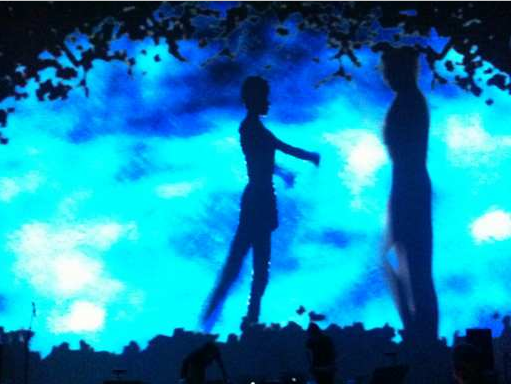 Wayang Listrik
Wayang Listrik
Ed Perkins
improvised audiovisual piece for two performers and their
avatars
 Block
Groove
Block
Groove
Nick Melia & Ed Kelly
electroacoustic composition and
sound
diffusion
 Momentum
Momentum
Andreas Weixler & Se-Lien
Chuang
audiovisual transformation
Andreas Weixler, audio
transformation
Se-Lien Chuang, visual transformation, bass recorder
Simon Waters, flute, electronics
Anton Lukoszevieze, cello
Ed Perkins, wine glasses, electronics
Bill Vine, wine glasses, electronics
live_mp3
YouTube video
program notes
Werkbeschreibungen und
Lebensläufe

die Augenblicke in
seinen
Händen
/ Dichte4Dichtl
audiovisuelle Kompositionen
Se-Lien Chuang
Die Komponistin und
Medienkünstlerin Se-Lien Chuang
lädt zur Präsentation ihrer aktuellen Kunstprojekte
die Augenblicke in seinen
Händen
und
Dichte4Dichtl im
Rahmen
der Konzertreihe Sonic Intermedia im DeepSpace des AEC. Die beiden
audiovisuellen Arbeiten sind mit Unterstützung der
Augenabteilung
des AKH Linz entstanden.
die
Augenblicke
in seinen Händen
Musik: cave (1999 / 2010) von
Se-Lien
Chuang
Audio Realisation in der University of Sheffield Sound Studios/
England,
1999 & Atelier Avant Austria 2010
Video Realisation in Atelier Avant Austria 2010
Katarakt Operateur: Dr. med. Johannes H.
Burger
Vorstand/Medizinische Leitung: Prim. Priv.-Doz. Dr.
Siegfried G.
Priglinger
Augenabteilung des
AKH Linz
Audio-/Videoaufnahme in AKH Linz
2010
Audio/Video Realisation in Atelier Avant Austria 2010
Stellvertretender Vorstand/Katarakt Operateur:
Dr. Manfred Dichtl
Vorstand/Medizinische Leitung: Prim. Priv.-Doz. Dr. Siegfried G.
Priglinger
Augenabteilung des
AKH Linz
Die Augenblicke in
seinen Händen (2010) von Se-Lien Chuang
Die Lichter rinnen
rinnen wie von weit,
als flüsterten sie in die Tiefe ferner Teich’;
sie rinnen mit vertrautem Geist.
Aus all dem dunklen Nichts
winkt das rote Ich,
das seine Spuren hinterlässt
in solch sanftem Winkelrest.
Wir alle rinnen,
die Zeit verronnen,
als rönne sie in die Herzen fernen Geists.
Es ist in allen, in unserem Fallen ...
Die Augenblicke zerfallen
im unendlichen Valet.
Doch ist da einer,
der vertraute ferne Geist,
welcher die Augenblicke meiner
in seinen Händen hält.
Se-Lien
Chuang

ist Komponistin, Pianistin und Medienkünstlerin, 1965 in
Taiwan
geb., lebt seit 1991 in Österreich.
Studien in Komposition KUG/Graz 2005 (B. Furrer), in Musik- und
Medientechnologie ABPU/Linz 1999 (A. Roidinger, K. Essl), in
Klavierpädagogik MHS/Graz 1996 (W. Groppenberger), Lehrgang
für Elektroakustische Musik MHS/Wien 1996 (T. Ungvary, W.
Musil).
Zahlreiche nationale/internationale Aufführungen von
Kompositionen
und Musikprojekten in Europa, Asien, Russland, Kanada, Süd-
und
Nordamerika in den Bereichen: Computermusik, audiovisuelle
Interaktivität, elektronische Musik, Ausstellungen bildender
Kunst
und virtueller Realitäten, zeitgenössische Musik,
algorithmische Komposition, zeitgenössisches
Instrumentaltheater,
Tanzperformance, Kunst-Video-Musik. Institutionelle Produktions-
und
Forschungsaufenthalte in Österreich, England, Nordirland,
Deutschland, Frankreich und Japan. Workshops, Gastvorträge
und
Lehrauftrag in Österreich, Deutschland, USA, Japan,
Süd-Korea, Taiwan. Publikationen in Deutsch, English und
Japanisch.
1996 war Se-Lien Chuang Gastkomponistin der UEA Studios in
Norwich.
Gemeinsam mit Gerfried Stocker, künstlerischer Leiter des
AEC, und
dem Komponisten Andreas Weixler begründet sie Sonic
Intermedia.
http://avant.mur.at/chuang
 Rotary/lateral
(Rondo)
Rotary/lateral
(Rondo)
realtime audio processing for cello and wine glasses
Simon Waters
Rotary/lateral sets out to investigate a series of musical issues
which
seem pertinent to the composer in 2010. The first of these is how
one
makes a performance – the shifting balance between the composer’s
issuing of an instruction set (in notation or in other coded
forms) and
trusting the musicianliness of the performers engaged in each
specific
performance characterises much of Waters’s post-acousmatic work.
Here
there are numerous ‘states’ of determination from relatively fixed
to
relatively improvised. But even the most improvised material is
consistent in its requirement that the players consciously explore
the
rotary and lateral gestural qualities associated with their
various
instruments. The ‘Bach’ bow used by the cellist at various points
forms
a sort of hybrid between the two types of physical input. Likewise
the
signal-processing software utilises agents which control
granulation
parameters in lateral and rotary virtual space. So the second
concern
is with the gestural – the paradoxical sense of ‘touching at a
distance’ which musically-produced sounds can invoke. The third is
with
how one integrates material which has historical references (the
rondo
form, the wine glasses representing the glass-harmonica,
references to
tonal material including the viola da gamba repertoire) with a
‘contemporary’ sonic sensibility.
The piece is scored for cello, wine glasses, whirling tube, and
laptop
(simple granular synthesis techniques).
Performers: Anton Lukoszevieze (cello), Ed Perkins and Bill Vine
(wine
glasses) and Simon Waters (computer)
Simon Waters
Simon Waters has been since 1994 the director of the
Electroacoustic
Music Studios at the University of East Anglia, although his
association with the studios began in 1980 when the studios were
directed by Denis Smalley. Much of his most well-known work
involved
the characteristic multi-loudspeaker diffusion of electroacoustic
music, often for contemporary dance companies, his ‘Dangerous
Liaisons’
of 1983 becoming one of the most performed such works because of
its
association with Ballet Rambert and the choreography of Richard
Alston.
His more recent work has returned to an interest in the proxemics
of
sound (whether sound occupies intimate, local, environmental or
virtual
space) and with live perfomance. In addition to composing and
performing Waters has curated the Sonic Arts concert series in the
UK
since its inception, and has guest curated events for many
festivals
and conferences including Ultima (Oslo), Fylkingen (Stockholm) and
SARC
(Belfast) and the ICMC.

Cellist Anton Lukoszevieze is one of the most diverse
performers of his
generation and is notable for his performances of avant-garde,
experimental and improvised music. Anton has given many
performances at
numerous international festivals throughout Europe and the USA
(Maerzmusik, Donaueschingen, Wien Modern, GAS, Transart, Ultima)
and
BBC Radio 3. Deutschlandfunk, Berlin produced a radio portrait of
him
in September, 2003. Anton has also performed concerti with the
City of
Birmingham Symphony Orchestra at the 2001 Aldeburgh festival and
the
Netherlands Radio Symphony Orchestra, as well as performances with
contemporary vocal ensemble Exaudi and King’s College Choir,
Cambridge.
He is unique in the UK through his use of the curved bow
(BACH-Bogen),
which he is using to develop new repertoire for the cello. From
2005-7
he was New Music Fellow at King’s College, Cambridge and Kettle’s
Yard
Gallery. Anton is the subject of several films by the renowned
artist-filmmaker Jayne Parker. Anton is also a member of
Zeitkratzer,
Automatic Ensemble, Agnes Nixon (an obscure duo with Jennifer
Walshe)
and in 2008 he made his contemporary dance debut with the Vincent
Dance
Company in Broken Chords, Dusseldorf.
Anton has premiered and commissioned new works for cello by a
multitude
of contemporary composers, including Christopher Fox, Gerhard
Staebler,
Amnon Wolman, Kunsu Shim, Laurence Crane, Richard Ayres, Sven
Lyder
Karhs, Jennifer Walshe, Claudia Molitor, Rytis Mazulis, Arturas
Bumsteinas, Juste Janulyte, James Saunders, John Lely, Tim
Parkinson,
Alwynne Pritchard, Peter Eotvos, Bryn Harrison and Mathew Adkins.
As an educator has taught at many UK Universities and abroad, in
addition he has given workshops on creative music skills,
contemporary
music performance, improvisational and compositional skills. From
2006-7 he was on the Music Faculty of Cambridge University and has
regularly led courses for the Aldeburgh Young Musicians Course and
has
recently given lectures at Brunel University, Durham University,
the
Slade School of Fine Art and the Vilnius Music Academy, Lithuania.
In June 2009 he was awarded the ‘Millennium Star’ medal, for
services
to Lithuanian culture, by the Government of the Republic of
Lithuania.
 Wayang
Listrik
Wayang
Listrik
improvised audiovisual piece for two performers and their
avatars
Ed Perkins
Taken from the Balinese term meaning ‘Electric shadows’, Wyang
Listrik
is an improvised audiovisual piece for two performers and their
avatars. Two lovers meet beneath the boughs of a forest lit only
by
stars and the gain of video feedback. The scene unfolds as the two
interact, communicating through non-verbal vocalizations and body
posture.
Using real-time animated silhouettes; the piece draws its visual
style
from the paper cutout animations of Lotte Reiniger and its sonic
elements from male and female vocal utterance. Each performer uses
their interface to control sound and image simultaneously, playing
out
an improvised narrative between their shadow characters. The cross
mapping occurs on a number of levels from sound/object
relationships to
grains of sound synchronizing with video frames.

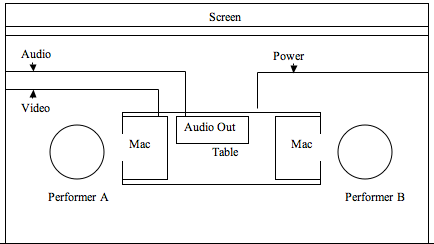
Ed Perkins
is an experimental artist specialising in creating electronic
instruments and real-time interactive audio-visual systems. His
work
focuses on the cognitive relationship between sound and image in a
performance context and the cultural relationship between media
objects
and their audience. These areas are explored through mythical
themes
and archetypical characters, with a strong literary influence from
fairytale and poetry.
Ed Perkins and Bill Vine (performers) are current PhD students
studying
with Simon Waters at UEA.
 Block
Groove
Block
Groove
electroacoustic composition and sound diffusion
Nick Melia & Ed Kelly
In the early 1990s many composers reacted against the smooth
professional surface which digital technology allowed, concerning
themselves with the signifying possibilities of noise, dirt and
distortion. An additional discursive dimension (analogous to the
spatial - to direction, or proxemics) emerged as musicians (and
other
digital artists) explored a continuum of resolution from distorted
to
clear reproduction, from deliberately compressed or reduced
dynamic or
spectral range to ‘professional’ polish. As an expressive device
this
continuum was well used by artists who emerged from the Bristol
club
scene in the early 1990s, notably Tricky and Portishead, and was
rapidly adopted by practitioners in electroacoustic music around
the
same time.
This continuum was articulated partly through the collision of
digital
‘hi-tech’ technologies with resolutely ‘lo-tech’ solutions to
musical
problems, and with the profusion of (often simultaneous) formats.
Many
artists adopted ‘lo-tech’ approaches as part of an explicit
political
agenda: avoiding implication in ‘corporate’ music making by
utilising
turntables, garage electronics and cheaply available (often
deliberately archaic) domestic music technology. Such issues,
along
with a pragmatic economic sense, informed the use of turntables as
performance devices in the urban subculture of the US in the
1980s, and
their use by experimental musicians (Christian Marclay, Philip
Jeck)
intent on drawing attention to the medium of the recording. A
typical
electroacoustic work from the UEA studios in the 1990s, Ed Kelly
and
Nick Melia’s Block Groove uses shellac, vinyl and digital
recordings
and the interventions, treatments and ‘degradations’
characteristic of
all three, to construct a piece in which there is play between an
‘acousmatic’ sensibility, the performed interventions, and
intrusions
from the material support of the recording which frequently emerge
as
‘content’. This might be interpreted here as a deliberate
McLuhanesque
signalling of the mode of representation, of the means of
encoding, as
inseparable from ‘what is represented’. (SW)
Nick Melia and
Ed Kelly were PhD students
studying
with Simon Waters at UEA in the 1990s. Both are still practising
musicians in the UK.
 Momentum
Momentum
audiovisuelle Transformation
von Andreas Weixler und
Se-Lien Chuang mit allen
Performer
Every performance of our interactive
audiovisual works, even of the
same title, is unique not only because of the inherent
concept
of improvisation and changing performers, but also because
the computer
system and the artistic concept
are further developed for every event and last but not least
the room
and architecture of the venue effects the appearance of the
composition.
Programmed in Max
Msp
Jitter (graphical and object oriented progamming
environment)
interactive video by Se-Lien Chuang
SpectraSonic System (multichannel spectraly delay, granular
synthesis,
FFT filtering and sound diffusion) by Andreas Weixler
Andreas
Weixler
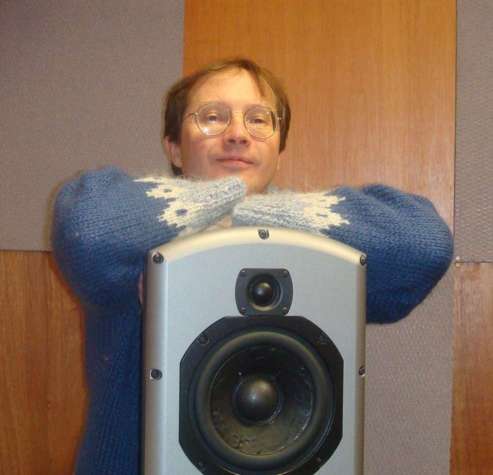
ist Komponist
mit Spezialisierung in Computermusik.
Seine Konzepte und künstlerische Arbeit fanden internationale
Anerkennung in Festivals und mehrmalige Auswahlen zu bedeutenden
Konferenzen der elektronischen Kunst und Computermusik wie NIME,
ICMC
und ISEA und zu einer regen Konzert- und Lehrtätigkeit in
Europa, Asien, Nord- und Südamerika. Seit 1997 betreut
Andreas
Weixler die Musik- und Medientechnologischen Fächer an der
Anton-Bruckner-Privatuniversität und unterrichtet seit 2004
an der
Kunstuniversität am Institut für Medien im Studienzweig
InterfaceCulture audiovisuelle interaktive Projekte.
1996 war Andreas Weixler Gastkomponist der UEA Studios in Norwich.
Gemeinsam mit Gerfried Stocker, künstlerischer Leiter des
AEC, und
der Komponistin Se-Lien Chuang begründet er Sonic Intermedia.
http://avant.mur.at
TEAMS
AEC
Mag.a Susi Windischbauer, Maria Seidl project management Deep
Space LIVE
Kathrin Meyer, Redaktion Ars Electronica Center
Florian Wanninger, DeepSpace Video Technik (Vorbereitung)
Florian Bauböck, DeepSpace Video Technik (Konzert)
Thomas Kollmann, DeepSpace Technik
Karl Schmidinger, DeepSpace Audio Technik
Heinz Sambs, Futurelab, Video Trailor
u.a.
ABPU
Mag. Andreas Weixler, Leitung, Organisation
Angelika Grabner, Veranstaltungsbüro
Jörg Lehner, EDV, Technik
Herwig Preiss, Tontechnik
Gerald Wolf, Foto
und Studierende Musik und Medientechnologie:
Baumgartner Martin, Kamera
Mira Kovacs, AEC-Kamera
Emily Stewart, Foto
Fabian Jungreithmayer, Foto
UEA
Dr. Simon Waters, studio director,
Elektronik
Ed
Perkins, Elektronik
Bill
Vine, Weingläser,
Elektronik
Anton Lukoszevieze, Violoncello
ATELIER AVANT AUSTRIA
Mag.a Se-Lien Chuang, Leitung, Organisation
Mag. Andreas Weixler, Leitung, Organisation
tech
specs
set up audio
set up visual
schedule
FOTOS
auf FB


